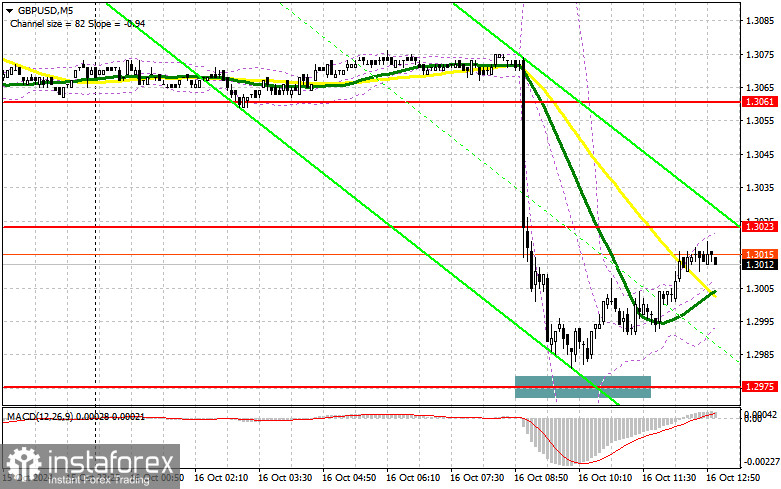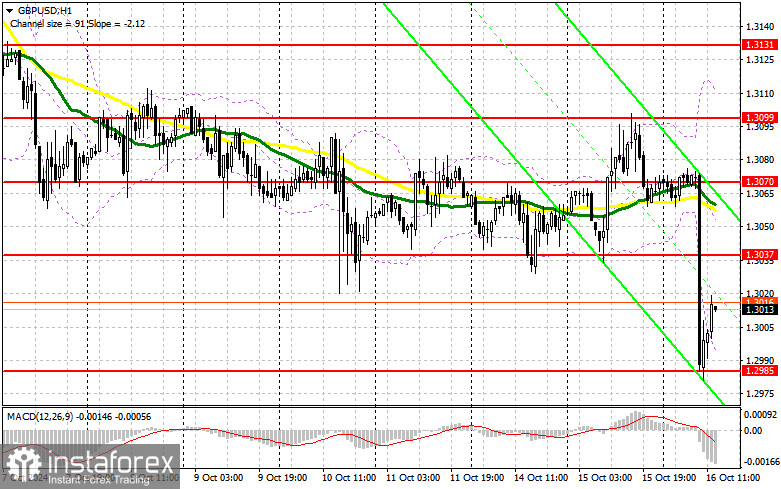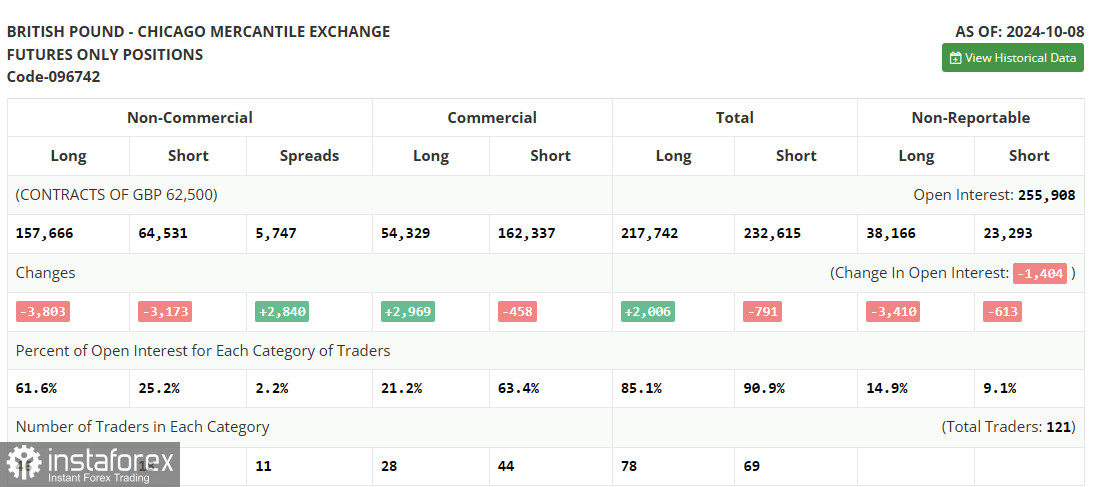In my morning forecast, I focused on the 1.2975 level and planned to make entry decisions based on it. Let's review the 5-minute chart and analyze what transpired. The pair declined but missed testing the 1.2975 level by just a few points, so I decided not to buy the pound, especially after such a massive sell-off. The technical outlook has been slightly adjusted for the second half of the day.

To Open Long Positions on GBP/USD:
Inflation data from the UK came in even lower than economists' forecasts; this resulted in a major sell-off of the British pound, as I warned in my morning forecast. There's no sign of buyers returning to the market, even after the sell-off, and the U.S. data isn't likely to help. The U.S. Import Price Index is unlikely to boost confidence among pound buyers. Therefore, a good entry point for long positions will arise only if GBP/USD falls and forms a false breakout around the 1.2985 level, offering the chance of recovery toward the 1.3037 resistance, formed after the European session. A breakout and retest of this range from top to bottom will strengthen the chances of an upward trend, leading to the removal of sellers' stop orders and providing an entry point for buying, with the opportunity to reach 1.3070, where the moving averages are located. Testing this level will undermine the sellers' plans for further decline. The furthest target will be the 1.3099 level, where I will take profits. If GBP/USD declines further and there is no bullish activity around 1.2985 in the second half of the day, the bearish market will return. This will likely result in further drops and a retest of the next support at 1.2941. Only a false breakout at this level will provide a good opportunity to open long positions. I will consider buying GBP/USD on a rebound from the 1.2911 low, aiming for an intraday correction of 30-35 points.
To Open Short Positions on GBP/USD:
Sellers have made their presence known, but there is no urgency to advance further. For this reason, I will aim to open new short positions at the highest possible level, around the new resistance at 1.3037. A false breakout at this level will offer a good selling opportunity, targeting the 1.2985 support, formed after the first half of the day. A breakout and retest from below this range will strike a blow to buyers, leading to the removal of stop orders and opening the path toward 1.2941. The furthest target will be the 1.2911 level, where I will take profits. Testing this level would reinforce the bearish trend. If GBP/USD rises and there is no bearish activity around 1.3037 in the second half of the day, buyers may attempt to regain the initiative lost after the UK inflation data. Sellers will have no choice but to retreat to the 1.3070 resistance. I will only sell on a false breakout. If there is no movement downward at that level, I will look for short positions on a rebound around 1.3099, aiming for a 30-35 point intraday correction.

The COT Report (Commitment of Traders) for October 8 showed a reduction in both long and short positions, almost by the same amount. The recent data from the UK hasn't helped the pound grow, but it has at least kept the pair within a fairly important sideways channel. This could lead to the end of the bearish market and the formation of a new bullish one. However, for this to happen, U.S. policymakers would need to start discussing aggressive interest rate cuts again, which seems unlikely at this point. The latest COT report indicated that long non-commercial positions fell by 3,803 to 157,666, while short non-commercial positions decreased by 3,173 to 64,531. As a result, the gap between long and short positions increased by 2,840.
Indicator Signals:
Moving Averages:
Trading is below the 30- and 50-day moving averages, indicating a further decline in the pair.
Note: The period and prices of moving averages are considered by the author on the hourly chart (H1) and differ from the general definition of classical daily moving averages on the daily chart (D1).
Bollinger Bands: In case of a decline, the lower boundary of the indicator at 1.2995 will act as support.
Indicator Descriptions:
- Moving Average (MA): Determines the current trend by smoothing volatility and noise. Period: 50, marked in yellow on the chart.
- Moving Average (MA): Determines the current trend by smoothing volatility and noise. Period: 30, marked in green on the chart.
- MACD Indicator (Moving Average Convergence/Divergence): Fast EMA period: 12, slow EMA period: 26, SMA period: 9.
- Bollinger Bands: Period: 20.
- Non-commercial traders: Speculators such as individual traders, hedge funds, and large institutions using the futures market for speculative purposes.
- Long non-commercial positions: The total long open positions of non-commercial traders.
- Short non-commercial positions: The total short open positions of non-commercial traders.
- Non-commercial net position: The difference between short and long positions of non-commercial traders.





















